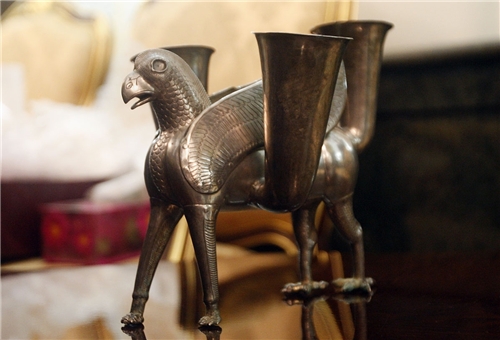
October 04-2013
Beyond the words and smiles of the past week, the United States decided to give a practical example of improving relations by returning to Iran a stolen pre-Achaemenid relic that was confiscated a decade ago by US Customs but which two successive administrations have refused until now to return to Iran.
It is a superbly preserved 2,700-year-old silver drinking cup or rhyton, looted from a cave in Iran and seized by US Customs officials in 2003. Its value is estimated at a million dollars or more, but it is actually priceless.
Its presence in New York has long been known. Iranian authorities have been seeking the rhyton’s return for years. The US has never claimed any right to the vessel. But it wasn’t in any mood to do Iran any favors—until now.
The ceremonial drinking vessel from the 7th Century BC, cast in the shape of a winged griffin, has been sitting in a warehouse in New York for years. And for years, US officials have been saying they couldn’t return it to Iran until relations between Washington and Tehran were normalized.
“This piece can’t go back,” the New York Post quoted James McAndrew, senior special agent in charge of cultural property for US Immigration and Customs Enforcement, as saying in 2010.
Last week, the piece flew back to Iran aboard the aircraft carrying President Rohani back home from New York.
“It is considered the premier griffin of antiquity, a gift of the Iranian people to the world, and the United States is pleased to return it to the people of Iran,” the US State Department said.
The statement went on: “The return of the artifact reflects the strong respect the United States has for cultural heritage property — in this case cultural heritage property that was likely looted from Iran and is important to the patrimony of the Iranian people. It also reflects the strong respect the United States has for the Iranian people.”
The ancient vessel is thought to be part of the Western Cave Treasure, a hoard of ancient silver that was found in a cave near the Iran-Iraq border in the late 1980s. Soon afterward, looters plundered the site, which was poorly protected, and some of those treasures found their way to the international antiquities market.
Federal authorities say a New York art dealer named Hicham Aboutaam brought the pre-Achaemenid artifact into the United States in 2000, and provided Customs officials with an invoice falsely claiming the piece came from Syria. Aboutaam negotiated a deal to sell the artifact to a collector for $950,000 — but, when federal agents caught wind of the sale, they seized the artifact and arrested Aboutaam on smuggling charges in 2003.
In 2004, Aboutaam pleaded guilty to a misdemeanor charge in connection with the false import claim and paid a $5,000 fine.
The head of the Iran Cultural Heritage, Tourism and Handicrafts Organization, Mohammad-Ali Najafi, held the rhyton aloft Saturday to display it for reporters, although many were appalled that he picked it up with his bare hands.
The artwork has been dated to the era of the Medes. In 612 BCE, the Medes rose up and, with foreign help, captured Nineveh and caused the collapse of the Neo-Assyrian Empire that had ruled the region for three centuries.
The rhyton is in the shape of a griffin with three drinking cups attached.
The griffin is a legendary creature with the body, tail and back legs of a lion; the head and wings of an eagle; and eagles’ talons as its front feet. As the lion was traditionally considered the king of beasts and the eagle was the king of birds, the griffin was thought to be an especially powerful and majestic creature. The griffin (shir dal in Farsi) was thought of as the king of all creatures. Griffins are known for guarding treasure and priceless possessions.
The historic griffin will be handed over to Iranian national museum for display, Najafi said.
Najafi accompanied Rohani on his visit to New York and is intent on organizing major cultural exchanges with the United States.
Najafi met with officials from New York’s Metropolitan Museum of Art about potential exhibitions of Iranian artifacts, he said.
He has also parlayed with academics from the Near Eastern studies program of University of Chicago, which has been studying cuneiform tablets from Persepolis for decades. “We agreed to have a joint program in future studies and research on these artifacts,” Najafi said.
As far as Najafi is concerned, the times of extreme tension between the two countries are over.
“Mr. Rohani, in an event held for Iranians last night (Thursday) specifically said that ‘the ice between Iran and the US has been melted,’ and I think if this is accurate, which I’m certain that it is, we will have no problems in the areas of education, sciences and culture in the next few months.”
Najafi is also interested in seeing the Pittsburgh Symphony Orchestra play next year in Tehran. If they can pull it off, he said, the concert would mark the 50th anniversary of the last time the orchestra played there.
























